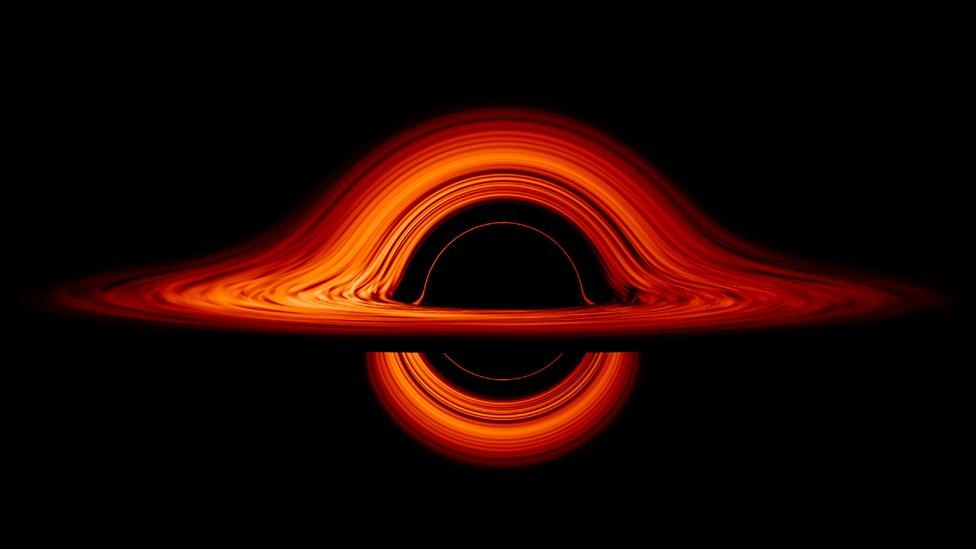Nobel in physics: Climate science breakthroughs earn prize
- Published

Computer analysis of the Earth's climate is important for informing efforts to tackle global warming
Three scientists have been awarded the 2021 Nobel Prize in Physics for their work to understand complex systems, such as the Earth's climate.
Syukuro Manabe, Klaus Hasselmann and Giorgio Parisi were announced as the winners at an event in Stockholm.
Research by Manabe and Hasselmann led to computer models of the Earth's climate that can predict the impact of global warming.
The winners will share the prize money of 10 million krona (£842,611).
It is incredibly difficult to predict the long-term behaviour of complex physical systems such as the climate. Computer models that anticipate how it will respond to rising greenhouse gas emissions have therefore been crucial for understanding global warming as a planetary emergency.
Indeed, the award comes as world leaders are preparing for a critical UN climate conference, known as COP26, to be held in Glasgow this November. Asked about the timing, Prof Parisi said: "We have to act now in a very fast way and not with a strong delay."
The climate models that have built on the winners' research form a crucial part of the evidence on which leaders at COP26 will base their decisions.
Japan-born Syukuro Manabe, 90, who is senior meteorologist at Princeton University in New Jersey, demonstrated how increased levels of carbon dioxide in the atmosphere could lead to increased temperatures at the surface of the Earth. In the 1960s, he led the development of physical models of the climate.
Roughly a decade later, Klaus Hasselmann, 89, from the Max Planck Institute for Meteorology in Hamburg, Germany, created a computer model that linked together weather and climate. His work answered the question of why climate models can be reliable despite weather being changeable and chaotic.

L-R: Syukuro Manabe, Klaus Hasselmann and Giorgio Parisi
On a superficial level, the original work carried out by Prof Parisi, who is currently at the Sapienza University of Rome, seems to bear little relation to climate change.
It was concerned with a metal alloy called spin glass, in which iron atoms were randomly mixed into a grid of copper atoms. Even though there are only a few iron atoms, they change the material's magnetic properties in a radical and very puzzling manner.
But the Nobel Committee saw spin glass as a microcosm for the complex behaviour of the Earth's climate. Complex systems, on atomic and planetary scales, may share certain features, such as being chaotic and disordered, with behaviour that seems to be governed by chance.
Parisi, who is 73, found that hidden rules influence the apparently random behaviour of solid materials - and worked out a way to describe them mathematically.
Prof John Wettlaufer, a physicist at Yale University in New Haven, US, explained: "What emerged from the committee's work was the duality between the study of Earth's climate - which is complex on scales from millimetres to the size of the planet - and Giorgio Parisi's work.
The Italian physicist was "building from the disorder and fluctuations of complex systems at [the level of] their microscopic constituents", Prof Wettlaufer said. The work of Syukuro Manabe, on the other hand, "is taking the components of individual processes and knitting them together to predict the behaviour of a complex physical system".
Prof Hasselmann's work encompassed both the microscopic and macroscopic worlds, added the physicist from Yale.
"Even though we've divided the prize between the climate part and the disorder part, they really are linked," he explained.
Dr Martin Juckes, head of atmospheric science and research and deputy head of the UK's Centre for Environmental Data Analysis (CEDA), said: "It is fantastic to see the work of climate scientists rewarded with the Nobel prize in physics today. The problems of complexity in climate systems, compounded by threats of the climate crisis, continue to challenge climate scientists today."
This year's physics laureates were announced during a news conference at the Royal Swedish Academy of Sciences. One half of the 10 million krona goes to Manabe and Hasselmann, while the other goes to Parisi.
The Swedish industrialist Alfred Nobel founded the prizes in his will, written a year before his death in 1896.
A total of 218 individuals have now won the physics prize since it was first awarded in 1901.
Only four of these laureates have been women. One physicist, John Bardeen, won the prize twice - in 1956 and 1972.
Follow Paul on Twitter., external
Previous winners of the Nobel Prize in Physics

Recent visualisation of a black hole by Nasa
2020 - Sir Roger Penrose, Reinhard Genzel and Andrea Ghez received the prize for their work on the nature of black holes.
2019 - James Peebles, Michel Mayor and Didier Queloz shared the prize for ground-breaking discoveries about the Universe.
2018 - Donna Strickland, Arthur Ashkin and Gerard Mourou were awarded the prize for their discoveries in the field of laser physics.
2017 - Rainer Weiss, Kip Thorne and Barry Barish earned the award for the detection of gravitational waves.
2016 - David Thouless, Duncan Haldane and Michael Kosterlitz shared the award for their work on rare phases of matter.
2015 - Takaaki Kajita and Arthur McDonald were awarded the prize the discovery that neutrinos switch between different "flavours".